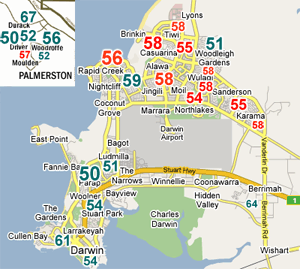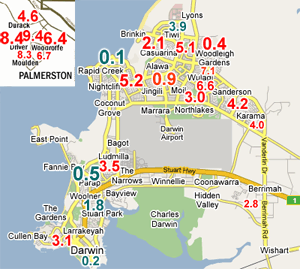Electoral Form Guide: Solomon
Electorate: Solomon
Margin: Labor 0.2%
Location: Darwin/Palmerston, Northern Territory
In a nutshell: Darwin’s diverse mix of demographic elements produces a highly marginal electorate, with the result being decided by 88 votes in 2001 and 196 votes in 2007. Damien Hale gained the seat for Labor on the latter occasion, and now faces a challenge from Palmerston deputy mayor Natasha Griggs.
The candidates
|
|
JOHN KEARNEY
|
|
|
Two-party vote map
|
Swing % map |
Electorate analysis: The Northern Territory recorded only a modest swing to Labor at the 2007 election, but it proved just sufficient to deliver them their first victory in the Darwin-and-Palmerston seat of Solomon. Created with the division of the Northern Territory into two electorates in 2001 (the remainder constituting Lingiari), Solomon’s distinguishing demographic characteristics are a high proportion of indigenous persons (10.3 per cent in the 2006 census compared to a national figure of 2.3 per cent) and a low number of persons aged over 65 (5.3 per cent against 13.3 per cent).
Darwin is divided between newer Labor-leaning suburbs in the north, including Nightcliff, Casuarina, Jingili and Sanderson, and the town centre and its surrounds south of the airport, an area marked by higher incomes, fewer families and greater support for the CLP. Stronger still for the CLP is Palmerston, a satellite town established 20 kilometres south-east of Darwin in the 1980s that accounts for just over a quarter of the electorate’s voters: it is less multicultural than Darwin and has a high proportion of mortgage-paying young families, no doubt explaining a particularly pronounced swing here in 2004. Swings to Labor at the 2007 election were around 7 per cent in Palmerston, lower in northern Darwin and non-existent around the city.
The Northern Territory gained its first member of federal parliament in 1922, but the member did not get full voting rights until 1968. Perhaps not coincidentally, the Northern Territory electorate had recently fallen to Sam Calder of the Country Party after a long period in Labor hands. With Calder’s retirement in 1980, the seat transferred to the Country Liberal Party, established as a local alliance of Liberals and Nationals to contest elections in the newly established Northern Territory parliament. Labor gained the seat with the election of the Hawke government in 1983, defeating CLP member Grant Tambling (who returned as a Senator four years later). It subsequently changed hands with great frequency: future Chief Minister Paul Everingham recovered the seat for the CLP in 1984, Warren Snowdon won it back for Labor in 1987, Nick Dondas held it for the CLP for one term from 1996, and Snowdon recovered it in 1998.
Going into the 2001 election, the new seat of Solomon had a notional CLP margin of 2.3 per cent while Lingiari had a notional Labor margin of 3.7 per cent. Warren Snowdon naturally opted for the safer option of Lingiari, and Solomon emerged as an extremely tight contest between Labor’s Laurene Hull and David Tollner of the CLP. Tollner suffered a 2.2 per cent swing against the national trend, but was able to hang on by just 88 votes. The Northern Territory’s hold on a second electorate looked set to be reversed at the 2004 election, when it was found to be 295 residents short of the required number. Since both major parties felt they could win them both (a more sound judgment in Labor’s case), the second seat was essentially legislated back into existence. This has left the two Northern Territory electorates with by far the lowest enrolments in the country: at the time of the 2007 election, Solomon had 57,641 voters and Lingiari 60,404, compared with 70,000 for Tasmanian seats and a national average of around 90,000.
After a relatively comfortable win in 2004, Tollner was defeated at the 2007 election by 196 votes, returning to politics in the Territory parliament a year later as member for Fong Lim. The incoming Labor member was Damien Hale, former coach of the Northern Territory Football League club St Marys. Following on from the tough act of Tollner, Hale has maintained the rough-and-ready standards associated with Territory politics: in January he apologised for an “exchange” in a Darwin nightclub with an NTFL football club captain who said Hale “had a few too many drinks and was saying stuff he shouldn’t”. As of the end of 2009 he was the Labor member most frequently ejected from the House of Representatives by Speaker Harry Jenkins. In July last year he was served with a domestic violence order from his estranged wife, before the two agreed to what the Northern Territory News described as “a mutual order restricting each from assaulting, threatening, harassing or contacting the other for the next 12 months”.
The Country Liberal Party has preselected Palmerston deputy mayor Natasha Griggs, said by the Northern Territory News to be a friend of Labor Chief Minister Paul Henderson. Griggs was chosen ahead of Darwin alderman Garry Lambert and Tourism Top End general manager Tony Clementson.
 The general consensus during the campaign, as articulated by Karen Middleton of SBS on the ABC’s Insiders program, has been that Labor would struggle to retain Solomon. However, the only published poll to emerge was from the massive JWS Research-Telereach “robo-poll” conducted during the final weekend of the campaign and accounting for 400 respondents, which had Labor leading 51.2-48.8.
The general consensus during the campaign, as articulated by Karen Middleton of SBS on the ABC’s Insiders program, has been that Labor would struggle to retain Solomon. However, the only published poll to emerge was from the massive JWS Research-Telereach “robo-poll” conducted during the final weekend of the campaign and accounting for 400 respondents, which had Labor leading 51.2-48.8.
Analysis written by William Bowe. Read Bowe’s blog, The Poll Bludger.
Back to the Crikey’s tipping comp electorate information page





